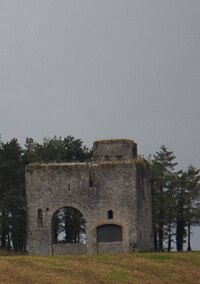Robert Dowdall
Sir Robert Dowdall (died 1482) was an Irish judge who held the office of
Career
He was the son of Luke Dowdall of County Louth. The Dowdalls were a Derbyshire family who originated at Dovedale, and came to Ireland in the thirteenth century, where they were mainly based at Newtown and Termonfeckin.[2] Later members of the family included George Dowdall, Archbishop of Armagh, James Dowdall, the Catholic martyr, and his cousin, also James Dowdall, Lord Chief Justice of Ireland.[1]

He was appointed
Marriage
He married (almost certainly his second marriage) Anne Wogan, daughter and co-heiress with her sister Katherine of John Wogan of
Robert resided mainly at Clontarf near Dublin.[1]
He was a companion of the
Attempted murder of Dowdall by Sir James Keating
Dowdall is chiefly remembered for the murderous assault on him in 1462 by Sir
The motive for the attack is unknown: Elrington Ball, comparing it to the murder of
Such incidents demonstrate a general breakdown of law and order in both kingdoms in the mid-fifteenth century, which greatly weakened the authority of the
This was not the only serious crime of which Robert was the victim: in 1455 he and his wife Anne petitioned Parliament for the restoration of their cattle, sheep and goods which had been unlawfully seized.
Later life
In 1474, he was a party to the charter establishing the Dublin Smith's Guild, which ranked third in precedence among the Guilds of the City of Dublin. It can scarcely have gratified him to know that his old enemy Prior Keating was another of the Guild's founders.[10] Two years later he was party to a similar charter setting up the Glovers and Skinners Guild.[11]
In 1478, Dowdall made a gift of 100 marks, to be invested in land or merchandise or loaned out at interest, to
Descendants
His only known wife was Anne Wogan, daughter and co-heiress of John Wogan of Rathcoffey, and widow of Oliver Eustace of Castlemartin. Robert had at least one son,
References
- ^ a b c d e f Ball F. Elrington The Judges in Ireland 1221-1921 John Murray London 1926 pp.100, 177-8
- ^ Otway-Ruthven, A.J. A History of Medieval Ireland Barnes and Noble 1993 p. 116
- ^ National Library of Ireland D. 18,590
- ^ a b c Patent Roll 37 Henry VI
- ^ Sir James Ware "Antiquities and History of Ireland" A. Crook Dublin 1705 p.15
- ^ Thomas D'Arcy McGee A Popular History of Ireland from the Earliest Times to Catholic Emancipation Montreal 1862 3 Volumes (p. 295, Volume I)
- ^ McGee History of Ireland
- ^ Ross, Charles Edward IV Methuen London 1974 p. 390
- ^ Brenan, M.J. Ecclesiastical History of Ireland Dublin John Coyne 1840 Vol. 2, p. 66
- ^ Patent Roll 13 Edward IV
- ^ Patent Roll 16 Edward IV
- ^ Bernard Burke, Arthur Charles Fox-Davies, 'Dowdall Formerly of Mountttown' in A genealogical and heraldic history of the landed gentry of Ireland (Dalcassian Publishing Company, 1 Jan 1912), p.191 (Retrieved 2 November 2022).

